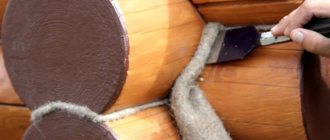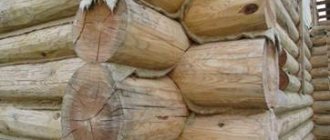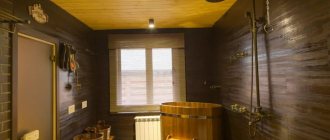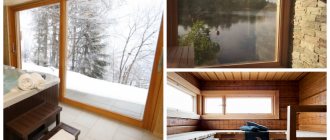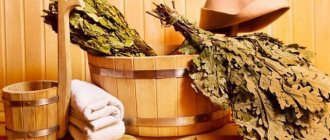The safety of a log bathhouse building largely depends on the choice of what and how to caulk the bathhouse, the ability to correctly identify future problems with the crowns, and mastery of tool skills. First of all, you need to know which inter-crown insulation to choose for a bathhouse. You can, of course, give up and seal the joints with silicone, but this will only make the situation worse. It’s still better to do a full-fledged caulking of the bathhouse with your own hands.
Why do you need to caulk a bathhouse?
Craftsmen usually answer such a question simply - so that the log house does not rot or fall apart. Without a seal, a log box becomes a cold, eternally creaking hut. If you do not caulk the bathhouse and seal the seams hermetically, then the supporting surfaces of the crowns will rot in a year or two and the log house will simply “sit down” or fall on its side to the north.
In addition to choosing how to caulk a log bathhouse, it is important to do the job correctly, so we will try to understand the means, tools and rules for caulking a bathhouse.
For high-quality seam sealing you will need:
- Packaging jute, flax tow, proven over the years, or any other type of sealant with a fiber structure;
- A set of tools - a wooden hammer, a spatula, a wedge knife and a hook for stripping a seam or an electric groove;
- Brush with stiff bristles;
- Carpentry measurer.
Advice!
There are few tools, but they will all be needed for the job. The first time you can rent them. After your first practical experience, it will become clear how to properly caulk a bathhouse, then you can buy a good kit or make it yourself. If you want to seal the seams with sealant, fortunately there are quite a lot of different brands and types of them sold for bathhouse needs, then in this case no tool other than a nozzle gun for a tube with liquid polymer will be needed at all. It is possible and necessary to spray the joints with sealant for a log bathhouse in one day; the technology requires laying the paste-like mass in two passes with a difference of no more than four hours. Any disruption of the process can lead to peeling of the sealant, whereas caulking the frame of a bathhouse can be done in a couple of days with interruptions.
Summarizing the above
The caulking of the bathhouse, according to all the rules, retains thermal energy in the bathhouse and significantly extends its service life.
Improperly carried out work on insulating a building will lead to its rapid cooling, rotting of the log house and the breeding of pests in it. Remodeling takes a lot of time, effort and material costs. Properly performed work will help increase the service life of the bathhouse. The erected structure will delight you for many years with its warmth, power and solidity.
Proper insulation of a bathhouse can be the key to its good quality and optimal heat retention. You can caulk the walls of such a building yourself, thereby significantly saving money
It is important to know well the basic rules of the process. Typically, such work extends significantly over a long period.
Choosing material for padding
Traditionally, seams and joints between wooden parts are sealed with a moisture-resistant, durable and necessarily easily deformable material. Interventional insulation for a bath can be made from:
- Synthetic polypropylene fibers, for example, in the form of a tape of woven and non-woven structure;
- Organic fiber, primarily jute cords and flax tow;
- Natural plant fibers from certain types of moss for baths.
For your information! Sometimes the problem arises of choosing whether moss or jute is better for a bathhouse, or they try to determine before starting work whether it is better to caulk with synthetics or organics. You need to choose based on the degree of shrinkage of the bathhouse frame and the size of the seam between the crowns.
Sealants
Modern sealants have long filled the construction market.
These are quick, convenient and easy-to-use products that are well suited for DIY work. However, in this case it is important to choose high-quality sealants from a reliable manufacturer, since some do not tolerate exposure to sunlight and wind.
As a result, they lose their beneficial properties and are blown away. Additionally, some types of sealants can damage the wood fibers when they dry. To avoid this, use elastic products (acrylic) that contract or expand with the wood.
At the same time, sealants have a large number of advantages, including not only easy and quick installation. Such products are characterized by high thermal insulation qualities, resistance to moisture, cold and temperature changes. Warm joints using acrylic sealants are in particular demand today. This product contains rubber, which gives elasticity and prevents small hidden cracks from cracking further.
Acrylic sealants are safe and environmentally friendly, so they are perfect for treating a wooden bathhouse or home. They do not emit toxic substances and allow the wood to “breathe”. These products can withstand high temperatures, do not have an unpleasant odor, and are distinguished by quick and easy finishing. They do not allow wood to rot and have a wide selection of colors. Read more about acrylic sealants and “warm joint” technology here.
What is better, moss or tow for a bath?
Today, both materials are recognized as the most durable and reliable of all traditional fiber seals. In both cases, the decisive factor is not even the type, but the quality of the preparation of the material.
Moss is recognized by all craftsmen as a universal means for sealing crowns. Most often they try to caulk the bathhouse with red or white moss. Bunches of plants are prepared 2-3 weeks before the start of work. Before caulking the bathhouse, remove debris and dry the moss under a canopy, periodically turning over and shaking the layers.
The organic matter should remain slightly moist. After drying, the fibers turn into a springy and strong wire-like structure.
Caulking walls with moss is not difficult; you just need to correctly measure the amount of material and the force of hitting the shovel with a hammer. The easiest way is to caulk the seams immediately on the new log house, after assembling the walls of the bathhouse. After shrinkage, after a year and a half, the procedure will have to be repeated with the same material.
For your information! Often, craftsmen who undertake to caulk the walls of a bathhouse tell stories about the bactericidal properties of mosses, the ability of the plant to germinate and completely fill the gap between the crowns.
In fact, the seal can bloom and turn green only if the birds have collected seeds and grass in the spring. If you caulk with organic matter, the seal can easily become a source of problems, from the appearance of fungus to green sprouts. Therefore, you still need to be able to prepare the moss for the bathhouse for caulking. If it’s too dry, the material becomes brittle and doesn’t hold well in the gap; too wet moss is very difficult to caulk into the seam.
Collection secrets
Although any moss is removed by hand, the process itself has nuances depending on the type of plant. As experts say, it is best to start preparing preparations from the end of June. Then the bryophytes, filling with juice, begin to acquire bactericidal and antifungal properties. They help prevent the appearance of rot in the log house.
To collect natural material, select an area with abundant moss growth. It is better if it is not a swamp, but an area near trees. On the one hand, the plants here are less watery, and on the other, they are in the shade and are not exposed to drying out under direct sunlight. A lush carpet, and not separately growing tufts, will be the best option for collecting natural insulation.
When removing vegetation, it is recommended to take as little land as possible. Apart from being heavy during transportation, it will not give anything. It would be wiser to get rid of cones, leaves and broken branches immediately, locally. Small blockages can be removed later, already at the stage of preparing the material for installation.
Sphagnum moss should be collected in sunny weather. In this case, drying it will take place without any particular difficulties. The fact is that after rains the plant is saturated with humidity up to 80-90%, which affects further processing of the material.
It is recommended to go for cuckoo flax in cloudy weather. It can be removed even in the fall, when the ambient air humidity is high.
The moss is placed in armfuls in bags, but under no circumstances is it compacted tightly.
How difficult is it to caulk the walls of a bathhouse with tow?
Tow or combed flax fibers twisted into bundles are safer than moss or jute. Due to its soft and thin structure, working with linen material is more difficult than with any other sealants. Tow is convenient for caulking the seams on the walls of a rounded bathhouse. Interventional gaps on log buildings are too large, so the fiber has to be folded into several loops. Technologically, this does not affect the quality, but it can seriously delay the caulking process over time.
Flax tow, thanks to the small amount of non-drying oils remaining in the fabrics, has the best damping properties of all possible sealants, both natural and synthetic. Tow for a bath is very well suited for sealing corner locks, especially hand-cut ones. When shrinking, the bathhouse log does not make frightening creaks and sounds; the process itself occurs without any complications.
The only drawback is the low durability of flax fiber. In a log house, tow caulk will last up to 5 years; in a bathhouse, the fiber burns out in 2-3 years.
How to prepare and lay moss for a log house?
A wooden frame - be it a house or a bathhouse - retains heat well, but without additional and effective caulking, this property is reduced to nothing. Any material available on the market can be used as inter-crown insulation in such a building. However, preference should be given to natural ones, which will provide reliable thermal insulation, but not interfere with normal air circulation.
Synthetic materials for caulking may have higher thermal characteristics, but they are not environmentally friendly . And in a wooden house their use is not very logical.
Based on this, it is best to use centuries-tested natural moss to insulate a wooden frame.
Jute fiber
Mechanically combed stems of jute hemp Jute Tassa produce a tough and at the same time durable fiber, which is used not only as a sealant on the walls of the bathhouse, it is an ideal material for containers and technical fabrics. Jute is produced in the form of coils, ribbons, and ropes, which allows you to caulk cracks on the walls of a bathhouse many times faster than using tow and moss.
Technical jute has only two disadvantages:
- High hygroscopicity;
- Susceptibility to rotting when soaked for a long time.
Jute for a bathhouse is interesting because during the shrinkage process it ideally fills the inter-crown space, especially if the log house is built from chopped logs. In this case, you only need to caulk with jute fiber and rope.
If, according to the project, the bathhouse building is planned to be covered with decorative finishing, the jute rope will simply rot in a couple of years. The tapes are laid to seal the crowns of the new log house; the rope is good for finishing the open surfaces of the walls of the bathhouse.
In fact, jute occupies an intermediate position between dense and hard moss and soft flax tow.
Drying
Natural material should be transported separately from the log house, in order to avoid any damage to the dense but soft structure of the moss. Immediately after its delivery, it is necessary to organize drying of the future insulation. There is no need to leave it in bags or dump it in heaps, as the plant will begin to rot and lose its quality. Drying moss is a critical stage in the preparation of the material.
Sphagnum is stored in small loose bunches, reminiscent of miniature haystacks. This technique helps preserve the rather fragile structure of the plant in the best possible way. Depending on weather conditions and the percentage moisture content of the moss, the drying process may take about 7-14 days. In no case should sphagnum be overdried, as it becomes brittle and therefore can crumble even before it is laid between the crowns of the log house. In addition, moss that is too dry is difficult to fix in place, as it blows away even with a slight gust of wind. In certain situations, sphagnum must be watered so that it acquires a certain elasticity.
It is better to immediately lay out Kukushkin flax in ribbons. The dried insulation is rolled into rolls, which subsequently speeds up the process of laying it into the inter-crown space.
Quite often, moss is dried directly in the forest, hanging bunches on dead bushes or low spruce trees. But it's not very convenient, actually. The disadvantage of storing plants in small stacks is poor ventilation, which can lead to the formation of mold. But there is a way that justifies itself in the best way. This is drying moss on racks. The material is laid out on horizontal surfaces formed using stretched ropes intertwined in the form of a mesh.
Moss is placed on the racks 20-30 cm thick. It is necessary to leave a distance of at least 35-40cm between the shelves to ensure proper ventilation of the layers on both sides.
The degree of drying is checked in a simple old-fashioned way. To do this, twist a small bunch and see what happens to it. If he:
Synthetic materials
In addition to natural fibers, you can caulk a bathhouse with more modern materials, for example, a composite cord consisting half of polypropylene threads and wool fibers. This type of caulking ensures strong retention of the seal even when the gap expands.
Caulking with synthetics is much more difficult; in addition, polypropylene burns out and crumbles under the influence of ultraviolet radiation, so for a bath it is best to use seals made of natural materials.
What to lay between the foundation and the timber. Features of the insulation process
Scheme of waterproofing the foundation from above under the timber.
Before proceeding with the installation of the first crown, insulation must be carried out, for which two layers of waterproofing material should be laid, between which a lining board should be placed.
The insulation includes two layers of rolled roofing felt and glass insulation. All materials are laid in such a way that their edges protrude 25 cm beyond the foundation. At the corners the insulation is overlapped.
Before the insulation is laid between the crown and the base, you need to check the surface of the foundation, which should be perfectly flat, without drops. To do this, use a hydraulic level, which is more accurate than a regular one. Differences of no more than 1 cm relative to the entire foundation plane are allowed. Strong differences are removed by laying roofing material or leveling with cement mortar.
An equally important point is to seal the gap between the foundation and the lower crown of the beam.
The most common method is to add cement mortar under a layer of waterproofing material. Carrying out work may be complicated due to the difficulty of accessing the desired location. In some cases, the gap is simply sealed with pieces of wood of a certain thickness. Wooden wedges or boards are attached between the roofing felt and the lower beam, which are driven tightly in until the gap is completely eliminated. There can be an unlimited number of such inserts in both length and width.
Scheme of laying timber on the foundation.
The most common method of sealing cracks lately is to foam them with construction foam, which is sold in cans. It will be better to carry out such work in damp weather, when the material sets very well.
A day after foaming, excess material is cut off with a sharp knife. Subsequently, the area between the lower crown and the base is covered with metal ebbs or a decorative strip. This is necessary in order to protect the foam from exposure to direct sunlight, under the influence of which it will collapse literally in one season. In addition, a reliable barrier is created for the accumulation of moisture, which will lead to rotting of the wood.
Seam filling technology
The process itself looks easy. In theory, it is necessary to caulk the crowns of a successfully constructed bathhouse twice, immediately after construction and upon completion of the shrinkage processes. In practice, caulking is done every three years, especially if the log has not been sanded and rounded.
First of all, before caulking the bathhouse, you need to inspect the seams, check and free the joint line from the old burnt-out seal. If the gaps in the inter-crown space of the bathhouse are supposed to be caulked with a cord or rope, then you will first need to measure the maximum drawdown of the crowns with a gauge.
This is done in order to determine the uniformity of shrinkage of the bathhouse building. If on one side the seal is pinched and compressed, and on the other it has fallen out of the cracks, then before caulking the box you need to determine the reasons for the uneven settling of the log house. At the same time, we specify the required thickness of the jute or flax hemp rope.
How to lay moss when assembling a wooden frame
In general, the process of laying a log frame on moss is not so tricky. Actually, moss as insulation is quite easy to use, which is why carpenters have used it at all times.
It will take a lot of time to collect the material and prepare it (dry it), but then everything depends on what kind of moss is used for thermal insulation.
If ordinary white moss (aka sphagnum) is used, then the laying technology looks like this: after fluffing it with your hands, we lay it in piles on top of the crown of the log house . The piles should fit as closely as possible to each other. At the intersections of the logs, that is, in the bowls, we place the moss more densely and overlapping. The insulation should extend beyond the edges by about 4 centimeters. We lightly press each pile with our hands, compacting it in this way. Cuckoo flax moss also needs to be fluffed a little with your hands before laying it down. This material is placed crosswise on the logs. Strips of moss should be laid overlapping.
Before you begin laying the insulation, the logs must be treated with special protective impregnations:
These chemicals will prevent wood from rotting or being damaged by fungi, mold or insects. It is important to do this in advance, since then there will be no access to these areas of the log house.
Another important nuance that you need to know about when laying moss is that the layer thickness should be at least 10 centimeters.
As the crowns are laid, pressure will be exerted on the insulation and it will simply be compressed. If there is not enough moss between the crowns, cracks will form over time, through which heat will escape from the house.
Sealing the material with tape
The easiest way to caulk a bathhouse is with a tape seal. After measuring the cracks, it becomes clear what width of tape should be used in this section of the log house. One end of the roll is secured in the gap at the corner, the sealing strip is carefully unrolled along the wall without twisting, a margin of 20-25 cm is left and cut off.
The ribbon laid out on the gap is carefully tucked into the gap so that the material does not sag or be stretched. Caulking begins from the widest edge, using a hammer and a wooden spatula with a rubber tip. The ribbon is pressed into the slot with light blows. It will be necessary to make 3-4 passes so that the sealant evenly and completely fits end-to-end between the crowns.
It will be necessary to caulk three or four pieces of tape before the desired joint seal can be achieved.
For your information! In this way, the cracks along the entire perimeter of the crown are sealed before it is possible to move to the next higher level.
If you caulk the entire wall at once, then one edge of the log house may rise by more than the thickness of the log, which will lead to the breakage of the upper rows of the bathhouse.
Caulking Tools
The toolkit includes:
- A stackable caulk with a blunt blade for working “as a set”; it is better to have two types of tools: with a 10-centimeter blade for caulking crowns and a 2-centimeter blade for cracks;
- The road worker for laying twists “in a stretch” has a wide blade thickened towards the bottom. A semicircular notch is made along the entire length of the blade;
- Breaking caulking with a wedge-shaped blade is driven into the cracks to widen them.
The tool is made of hardwood or soft metal and has a handle that is comfortable for work. A mallet is used as a percussion instrument - a hammer with a wooden or rubber striker.
Caulk joints of tow
The procedure for sealing the inter-crown space with bundles of fibers, such as tow or linen yarn, is a little more complicated. After cleaning the seam between the logs, the future place where the tow will be laid is rubbed with a mixture of formaldehyde, alcohol and linseed oil. You can impregnate individual cords with a disinfectant mixture before laying them in the wall of the bathhouse.
You need to caulk the bathhouse wall in the same sequence as when using tape. If the thickness of the seam is small, then the material can be laid by immediately rolling cords of 2-3 mm thick from the fiber. A tightly rolled roll of tow applied to the gap, without blows, is carefully pressed into the gap with a spatula.
For the next pass, roll up a thicker cord from tow, about 3-4 mm; this time you need to caulk the seam with force. For the last pass, a thick rope is rolled up, sometimes up to 8 mm. The material is hammered into the gap so that the edge protrudes above the line of the bathhouse crowns by no more than 3-4 mm.
If there are wide cavities between the crowns, they are caulked with additional ropes made of tow with a lubricant of any rubber-based elastic adhesive. In the same way, cracks in the logs of the bathhouse walls are clogged. The repaired areas are rubbed with additional acrylic paste.
Basic principles
The quality of the log house's assembly is determined by how the crowns are laid. It is important not only to cut out the bowls and grooves correctly, but also to lay inter-crown insulation between two rows of logs or beams.
The insulation is installed during the assembly stage of the log house
What it will be - moss, tow or jute - is up to you, but such a layer must be present. When building a log house, you need to lay insulation in two layers:
- on the lower crown so that the edges of the insulation protrude beyond the edges of the bowl by 3-5 cm, the width of the insulation, in general, is taken 5-10 cm more than the width of the bowl;
- Insulation is also placed in the bowl of the upper crown; its edges protrude beyond the bowl by 3-5 cm.
Please note that when using moss or tow, there is no need to “tap” the material. When tapped with a hammer or an ax butt, the moss fibers break and dents form on the wood, which are directed across the fibers. Such damage can lead, in the future, to the development of foci of rotting. It is enough to simply compact the fibers with the palm of your hand, leveling and probing the layer; if you come across large foreign objects (cones or sticks are often found in moss), simply remove them.
Laying moss when assembling a log house
When using tape insulation, you can fix it using a construction stapler - damage to the wood from the staples is minimal, and the material is held securely. It is advisable for two people to lay the “insulated” crowns so that they can take the log from both ends and lower it so as not to move the insulation.
Advantages of moss insulation
Natural materials are especially highly valued in construction today. Technologies that have long been used in construction in Rus' are today regaining popularity among those who want to avoid artificial, often toxic synthetics as much as possible. Many common insulation materials reduce the environmental friendliness of a building because they impede the passage of air and water vapor. Moss is free from this drawback, as it fits harmoniously into the structure of the house, providing it with protection. Another plus is that cuckoo flax itself has antiseptic properties, so it also helps to increase the durability of the building.
Properly performed insulation using ancient technologies allows you to forget about drafts and ventilated corners, and the room will always be warm and comfortable. One of the advantages will be the forest aroma, which many people like.
What to caulk with?
Of course, you cannot caulk cracks in a bathhouse with ordinary cotton wool - this will require more suitable, ideally natural, materials. An alternative to them may be industrial sealants.
Moss
Moss is considered to be the most commonly used material for these purposes. Despite the fact that today a sufficient amount of materials has appeared, this plant still remains in a leading position due to its outstanding characteristics. The environmentally friendly material has a significant antibacterial effect and provides high-quality thermal insulation. It is not prone to rotting and can be used for a long time. It is also worth mentioning that microorganisms do not multiply in moss.
However, the material has a number of disadvantages. Considerable time will have to be devoted to selecting and collecting moss. Samples that are too wet will contribute to the rotting of the structure, and samples that are too dry will break and crumble. We must not forget that buying moss costs a significant amount. Natural material is not particularly easy to lay out, so it is better to combine it with tow.
Before starting work, the moss must first be left to dry in the fresh air, turning regularly. Then the material is soaked for 30-60 minutes, wrung out and then laid out in a layer and leveled so that the ends of the fragment hang from both ends of the frame. When all the logs are laid, the excess fibers will have to be shortened, or wrapped and tucked back into the cracks. Subsequent stages of work will occur only after 6 months and 1.5 years, and the entire process will be a three-stage process.
Jute
Recently, jute fiber has been used quite often to caulk cracks in a building. This material promotes high-quality thermal insulation due to the presence of natural binding resins and does not get wet at all, even in conditions of high humidity. It is worth noting that fiber rarely deteriorates due to rotting. The environmentally friendly material fits well between the logs, simplifying the entire caulking task.
It is customary to distinguish three main varieties of jute.
- Jute tow is formed by combing the fiber and aligning it in the required direction. The material retains its properties, but its rigidity and low density complicate the caulking process. Since the fiber dries out, it has to be laid out several times. There is also a high probability that the tow may simply be stolen for birds’ nests.
- Jute felt is formed by combining 90% jute and 10% flax fibers. The flexible material is easier to work with than tow, but its short length can be a problem, causing it to fall out. To prevent this situation, it is better to select fibers that are at least 20 millimeters in length. It is for jute felt that moths appear.
- Flax-jute looks like a ribbon created by combining soft flax and hard jute fibers. It is easy to use, but is prone to rot and requires pest control. In its properties it resembles flax wool.
Tow
Tow is the waste remaining after the first stage of processing of jute fiber, hemp or flax. This material is very inconvenient to work with; in addition, it is very often subject to rotting and transformation into dust, which has to be cleaned out and caulked again. However, this fiber is an environmentally friendly material with thermal insulation and antibacterial characteristics. The higher the quality of the initially processed material, the better the quality of the tow. These fibers are cheap and available. Tow is sold in blocks and rolls. During caulking, the required amount of material is removed from the packaging, which is twisted into a rope and used to fill the seam.
Laying moss in the seams
Caulking seams with moss is an old method. And if you decide to caulk with moss, then the first thing you need to do is choose the right material. “Cuckoo flax” is suitable for this process. It has long fibers of a brown-brown color with a reddish tint.
They also use “white”, which is called “sphagnum”. This is soft moss, like cotton wool. This type of moss has bactericidal and antimicrobial properties. This material does not harbor wood pests; it destroys fungal spores. These species are called building mosses.
When constructing a log house, the material is placed between the crowns of logs, and it serves as insulation. The material is subsequently used for caulking. This is done at least 2 times: used after assembling the log house, after its shrinkage. Shrinkage occurs within 1.5–2 years, and sometimes more.
Before caulking, the moss is dried. However, before starting the caulking process itself, it is wetted, otherwise it will crumble in your hands and it will be impossible to do any work with it. Caulking with moss is carried out with special tools: caulking, mallet.
The caulking tool is made from the same wood as the log house. This is done so that the tool and the log have the same hardness upon contact. Then there will be no traces left on the log house. A wooden hammer is used to strike the caulk, which makes it possible to push the moss into the crack with force and tightly fill the space.
Caulk with moss begins from the bottom row, passing along the perimeter. This approach avoids distortions. The crown passes completely from the outside to the inside. Before use, “Kukushkin flax” is formed into 100 mm strips, laid parallel to the log, and cracks and cracks are sealed using special tools. White moss is fluffed up a little before work. The laying is done perpendicular to the log with hanging fibers on both sides of the log by 100 mm, which are then pushed into the gap with tools.
Caulking moss on a log house is not a difficult job, but it does require care. We must ensure that the house does not warp, that the seams are complete, that the logs do not fall out or tear apart from each other. What is needed in this matter is perseverance, time, and patience.
Labor intensity of work
It is also necessary to take into account that when caulking, the height of the house increases by an average of 10 cm. If the technology is not followed and the caulking is incorrect, you can get a distortion in height, which results in deformation of the entire structure. Therefore, it is not recommended to caulk the house yourself; it is advisable to entrust this work to professional craftsmen.
The process of sealing joints and cracks with sealant is not particularly difficult; installation work is carried out quickly without noise and dust. Sealed seams do not in any way affect the height of the building, which remains at the same level. The main thing in work is not to deviate from technology, which also requires professionalism.
